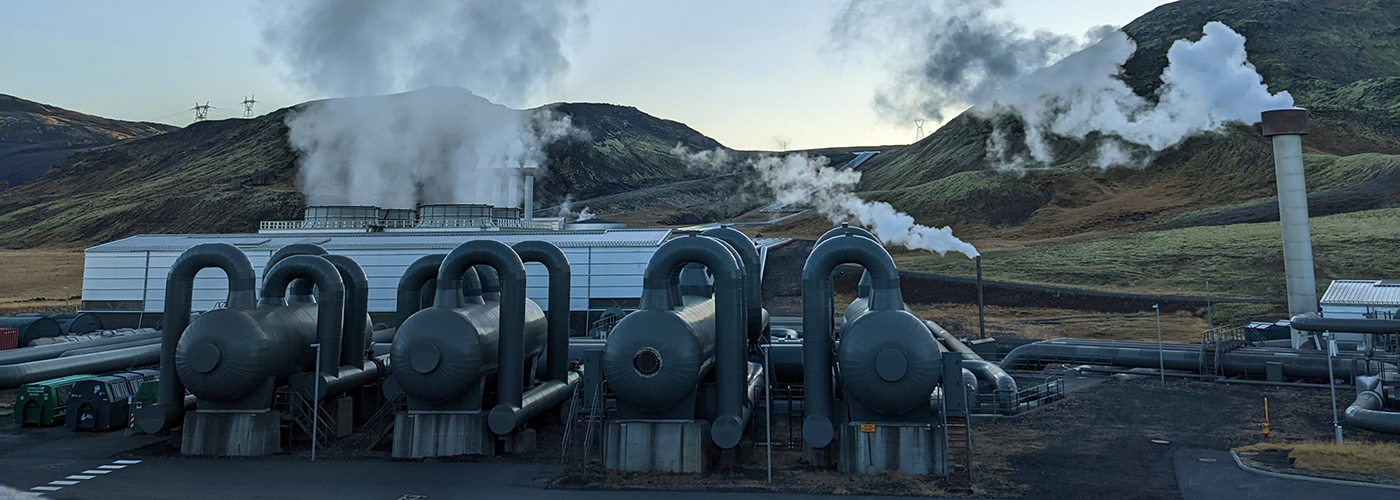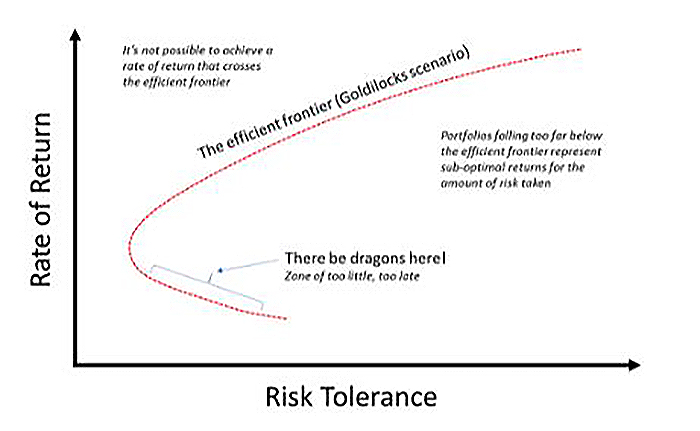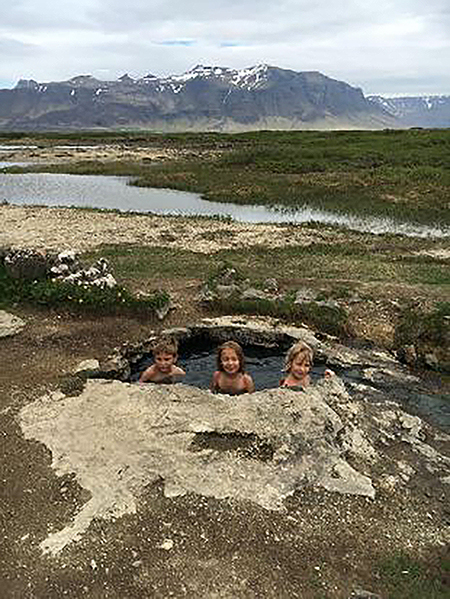Alaska’s Energy Future: A view from my hot tub
First in a series of eight articles
By Gwen Holdmann
May 22, 2023

View of ON Hellisheiði geothermal power station from the ON Geothermal Exhibition at Hellisheiðarvirkjun.
Whenever faced with difficult or complicated conversations, my kids and I have found that the hot tub on our deck makes an excellent venue. It’s the perfect combination of being relaxed, but also not being distracted by electronics or the “noise” of daily life. It’s become part of our family vernacular – mom, let’s pin that, it’s a hot tub conversation. I have learned a lot about things that impact my kids or how they are thinking about things while outdoors, in my bathing suit, watching the northern lights.
A few weeks ago, right after dinner, my 14 year old son came up to me in his swimsuit with a towel in one hand and a chessboard in the other and challenged me to a game of hot tub chess. This was a new concept, but I figured I need to take advantage of these one-on-one times while he still wants to hang out with his mom. So we played chess (predictably, he trounced me thoroughly), and then I took the opportunity to talk to him a little bit about Alaska and the future.
Of all my kids, he is the one most deeply steeped in an Alaska lifestyle. He ran the Junior Iditarod earlier this year, and he routinely tests the shocks on my crappy 20 year old snowmachine. He also used his chore of shoveling off the porch as a chance to set up a downhill ski jump right off the deck! I asked him what he thought it would mean for him if we had access to cheap energy.
He was quiet for a bit. “Well,” he said, “I really want to work in the tech industry when I grow up.” (He is an avid computer programmer). “I worry because I want to stay in Alaska, but the tech industry is not here. Maybe if we had cheaper energy, there could be more things happening in Alaska, and I could stay here.”
That was the first time we have talked about the future – his future – like this, but I realized this is something he had already been mulling over. Alaska is a great place to live, but so many of our kids leave because they don’t see great work or job opportunities for themselves. We need to change that, in all sorts of ways. But energy is certainly a factor in that equation, and if we can invest in energy infrastructure we invest in Alaska’s future, and the future of our youth.
Can Alaska Achieve the Lowest Energy Costs in the World?
Without a doubt, Alaska has the resources and assets to produce some of the cheapest energy in the world. There is no form of energy that is not available in some corner of the state, from our vast fossil energy resources, to every possible flavor of renewable energy. No other U.S. state - or probably country in the world - taps as diverse a set of potential energy sources as Alaska. Despite these resources, however, we currently have the highest energy-cost burden in the U.S. The challenges associated with cold climates, isolation, our small distributed population and declining state budgets are all contributing factors to these costs, but smart investments in energy resources and infrastructure could change all that. Do we have the political and societal will to make these smart investments? Can the work we do now leave an inter-generational legacy of stable, cheap energy in Alaska?
Alaska has so many options that sometimes, this can be a hindrance to decision making. It’s human nature that when faced with too many choices, gridlock can ensue leading to decision paralysis. We have been there before. A decade ago, we came within a millimeter of pulling the trigger on the Susitna Hydroelectric Project before Governor Walker pulled back on the throttle in favor of pursuing a large- diameter natural gas export line. And partially as a result of that decision, the utilities on the Railbelt each went their own ways and invested in their own local pet projects. This ultimately resulted in a big infrastructure spending spree and a 25% increase in installed capacity while the average load stayed about the same. Was this a bad decision? A missed opportunity?
I recently learned about a concept used in asset portfolio management called “the efficient frontier.” It is usually used by financial managers to balance risk and expected returns for investment portfolios, but it can be applied equally well to a portfolio of energy projects. It’s based on the concept of optimizing the amount of risk you take in making a decision, compared to the potential benefit you can gain from taking that risk. The efficient frontier is the curve that reveals itself when thousands of computer simulations are run for decision risk and their outcomes. It is not possible to cross the efficient frontier under real world uncertainty - that’s because this threshold represents the optimal “Goldilocks” scenario that offers the highest expected return for a defined level of risk. Ideally, you want your investment strategy - whether in a mix of energy projects or in your financial portfolio - to get as close to the efficient frontier as possible. Portfolios that lie too far below the efficient frontier are sub-optimal because they do not provide enough return for the level of risk taken.

You can never get to zero risk, of course, because there are so many unknown factors the future obscures. But if you delay taking risk or choose to minimize all risk, it’s possible to land in a truly awful quagmire. That’s because rather than getting to zero risk and zero reward, the efficient frontier curves back on itself. Should you find yourself exploring this part of the frontier, you are in a very unfortunate predicament. Even if you belatedly start to take on additional risk, you will continue to slide down the curve and continue to lose out on the potential benefits that might have been available, had you acted sooner. That is the too little, too late scenario. The moral of the story is that a non-optimal decision made earlier is sometimes better than no decision at all.
For the Railbelt utilities, much of the generation brought online over the past decade was more efficient and flexible than legacy equipment like the old simple cycle natural gas turbines at the Beluga Power Plant located on the west side of Cook Inlet. So, given the constraints they were operating within at the time, they could not be considered poor choices. But was this the best decision we could have made? Did we get as close to the efficient frontier as we might have with a more organized process for investing in our future energy portfolio? Probably not. Do we have another chance to think through our best course of action? Yes. Does that mean Susitna is the optimal choice? Perhaps, perhaps not. There are many variables to consider, and a plethora of other options. But one way to guide our decision- making is to turn to other markets that have pushed the efficient frontier of risk versus reward, and won.
Iceland’s Path to Cheap Energy
When Iceland made the decision to invest in geothermal and hydroelectric half a century ago, those were the only cards they had to play in the energy game so they didn’t have to agonize too much on where to invest public resources. They also had the extra motivation to achieve energy independence after being cut off from energy supplies (mainly coal) from Europe during World War 2, later compounded by the 1970s oil crisis. At that time, no other country in the world had systematically invested in geothermal as the backbone of their energy supply. There wasn’t even an engineering program at their university and the underlying geology of their geothermal resources was not yet well understood. With strong political and societal alignment around energy security, Iceland got busy.
There was calculated risk associated with this strategy, but Iceland systematically developed the needed skills and expertise, and invested in the buildout of their local renewable energy resources - and it paid off. Today they are a global leader in clean energy, though they still rely on imported fossil fuels for those pesky challenges of cars, planes, and boats, including their fishing fleet. Nonetheless, what they have achieved is a real testament to what a society can accomplish when it gets its act together and everyone starts rowing in the same direction.
While their achievements in renewable energy development often take center stage, there are some notable side benefits. Icelanders have access to some of the cheapest energy in the world today. That’s important to note because local, renewable energy does not always equate to cheap energy. But in Iceland, although they have differential rates for residential, commercial and industrial customers, the average rate hovers somewhere around 10 cents a kWh. Their cost for space heating through piped district heating loops is so cheap, they rarely bother to turn down the thermostat. My family and I lived in Iceland for a while when I was a Fulbright Scholar. I never got used to Icelanders opening up the windows in their homes in mid-winter when it got too warm inside (they also have a habit of leaving their babies outdoors in winter to nap in their strollers because the fresh air is good for them, but that is another story).
Cheap and freely available power very likely has been the biggest determinant in another side benefit – affluence. At the turn of the last century, Iceland’s GDP was roughly equivalent to many sub-Saharan African nations. It was by far the poorest country in Europe, dependent almost entirely on their cod fishing industry. Coal and sheep dung were the primary heat sources and sod houses were commonplace. In just a generation or two, smart energy resource investments improved the standard of living in Iceland by an order of magnitude. The north Atlantic island nation is now highly connected to the global economy, with thousands of small businesses including many in the innovation sector, and regularly ranked as one of the top three happiest countries in the world.

In a country where many Icelandic families have lived on the island for over 500 years, investing in the broad and innovative buildout of geothermal resources was a no-brainer. Iceland had the social and political will to make these investments as a lasting legacy for their children, grandchildren, and great grandchildren. For many Alaskans, who’s recent history is closely coupled with extractive industries, political cycles, and the outflow of both people and their earnings from the state, this type of long-view requires some readjustment of our decision-making framework, and how we invest the resources we have. It can be hard to wrap our heads around making some of the generational investments in infrastructure, when as individuals we don’t know if our children and grandchildren will benefit from them.
This brings me back to the hot tub with Leif. I don’t have any way to prove this, but I am almost positive that Iceland has more hot tubs per capita than anywhere on earth. I wasn’t really a huge fan of soaking in hot water until we spent time there. Now that I think about it, my family’s hot tub conversations were probably inspired in part from Iceland’s culture of meeting people to talk and relax in a hot pool somewhere. Why stay in the office? I had many unofficial meetings in Iceland relaxing outdoors with friends and colleagues, learning from one another. And since my kids experienced this as well, our hot tub is a connection back to Iceland for us. And Leif would have no trouble finding a job in Iceland in the tech industry. There is a thriving, vibrant, startup and tech ecosystem there. His instincts are almost certainly right – cheaper energy attracts industry, or creates new opportunities for businesses to flourish.
Can Alaska get there? It depends on if we can develop an organized approach to our energy future, like Iceland did, and ride as close as we dare to the “efficient frontier” to navigate our own path to a low- cost energy future. Given our often-used nickname of “the Last Frontier,” I hope we can capture our pioneering spirit to do so. I’m not sure if we can accomplish what Iceland has, but I believe we owe it to our youth to try. And, if we succeed, we can truly live up to our official state motto - North to the Future.


